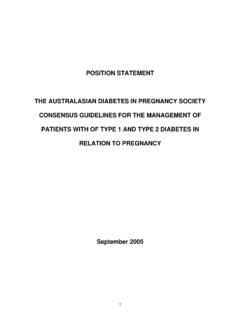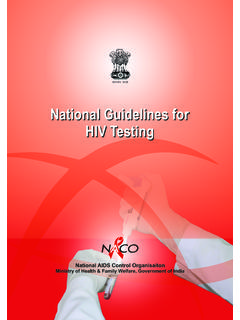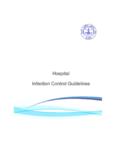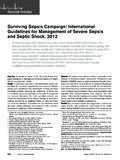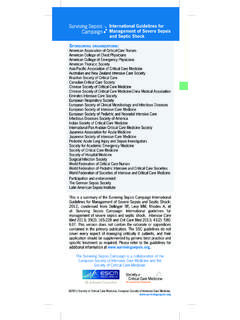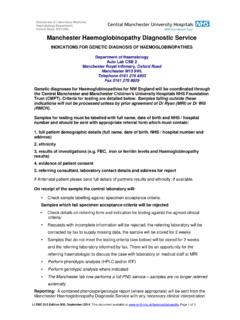Transcription of ADIPS Consensus Guidelines for the Testing and of ...
1 Page 1 of 8 ADIPS Consensus Guidelines for the Testing and diagnosis of gestational diabetes mellitus in australia Nankervis A, McIntyre HD, Moses R, Ross GP, Callaway L, Porter C, Jeffries W, Boorman C, De Vries B, McElduff A for the Australasian diabetes in Pregnancy Society The Australasian diabetes in Pregnancy Society ( ADIPS ) originally formulated recommendations for the Testing and diagnosis of gestational diabetes mellitus (GDM) in These Guidelines were primarily based on expert opinion. With some local variations, the ADIPS Guidelines have been used nationally since that time. In the light of more recent evidence, ADIPS has elected to revise these Guidelines in the current document.
2 Recommendations for future research are summarized at the end of this document. The Hyperglycemia and Adverse Pregnancy Outcome study (HAPO) published in 20082 was a large, prospective, blinded, multinational, observational study that examined pregnancy outcomes in 23,316 women whose plasma glucose (PG) levels were fasting and 2 hrs post 75g oral glucose load. This study reported a strong correlation between increasing maternal glucose levels at 24 32 weeks gestation and a range of adverse maternal and fetal outcomes. Subsequent consideration by the International Association of diabetes and Pregnancy Study Groups (IADPSG), with Australasian representation, resulted in the formulation of new Consensus Guidelines for the Testing and diagnosis of These Guidelines have been endorsed by several national organisations including the American diabetes Association4.
3 There has been a change in the demographics of women becoming pregnant and an increase in the rate of type 2 diabetes mellitus (DM) in the Australian This has resulted in more women of childbearing age having abnormalities of glucose tolerance, including undiagnosed DM, detected for the first time during pregnancy. The definition of GDM will remain as glucose intolerance of variable severity with onset or first recognition during pregnancy. The diagnosis of GDM will therefore include those women with previously undiagnosed abnormalities of glucose tolerance, as well as women with glucose abnormalities related to the pregnancy alone.
4 A definitive diagnosis of non gestational diabetes cannot be made until the post partum period. Because of this uncertainty, ADIPS does not currently recommend the use of the term Overt diabetes (as proposed by IADPSG) to describe marked hyperglycaemia (consistent with diabetes if detected outside pregnancy) first detected in pregnancy. However, clinical judgement should be used to detect marked hyperglycaemia, especially in early pregnancy (first visit). These women are at higher risk of major pregnancy complications and require urgent attention, including evaluation for other complications of undiagnosed diabetes .
5 Page 2 of 8 1. Recommendations for early Testing for GDM for women with risk factor(s) Women, not known to have pre existing glucose abnormalities, but with risk factors for GDM (vide infra) should be tested early in pregnancy. We recommend a tiered approach to early glucose Testing . Moderate risk factors for GDM Ethnicity: Asian, Indian subcontinent, Aboriginal, Torres Strait Islander, Pacific Islander, Maori, Middle Eastern, non white African BMI 25 35 kg/m2 Women with either ethnicity or a body mass index (BMI) of 25 35 kg/m2 as their only risk factor should be considered as moderate risk and should initially be screened with either a random or a fasting glucose test in early pregnancy, followed by a pregnancy OGTT (POGTT) if clinically indicated.
6 The thresholds for further action are not clear at present and clinical judgement should be exercised. High risk factors for GDM Previous GDM Previously elevated blood glucose level Maternal age 40 years Family history DM (1st degree relative with diabetes or a sister with GDM) BMI > 35 kg/m2 Previous macrosomia (baby with birth weight > 4500 g or > 90th centile) Polycystic ovarian syndrome Medications: corticosteroids, antipsychotics Women at high risk of GDM (one high risk factor or two moderate risk factors) should undergo a 75 g POGTT, with venous plasma samples taken fasting, one hour and two hours at the first opportunity after conception.
7 Women considered as moderate or high risk but with normal early pregnancy glucose Testing should have a repeat POGTT at the usual time of 24 28 weeks However a POGTT should be performed at any earlier time during pregnancy, if clinically indicated. Page 3 of 8 2. Recommendations for routine Testing for GDM All women not known to have GDM, should have a 75g POGTT at 24 28 weeks gestation. All women should be tested, as stratification by risk factors is unreliable. The glucose challenge test (GCT) lacks both sensitivity and specificity and is no longer part of the diagnostic algorithm. There is also no need for a 3 day high carbohydrate diet before the POGTT.
8 3. Recommendations for diagnostic criteria for GDM The HAPO study demonstrated no specific plasma glucose values above which the risk of adverse pregnancy outcomes was markedly increased. Therefore the IADPSG Consensus panel recommended that cut points for the fasting, 1 hour and 2 hour plasma glucose levels associated with an odds ratio of for adverse outcomes compared to the rates seen at mean glucose levels of the HAPO cohort should be designated the diagnostic levels for GDM. Primary outcomes of the HAPO study were birth weight >90thpercentile, caesarean section delivery, neonatal hypoglycaemia and cord C peptide >90thcentile2.
9 Outcomes used in determining cut points were excess fetal size and adiposity (>90th centile) and cord C A diagnosis of GDM is made if one or more of the following glucose levels are elevated; Fasting glucose 1 hr glucose 2 hr glucose Levels of evidence The diagnostic criteria have been chosen from HAPO2 a large, observational study. The 0, 1 and 2 hour values were chosen to identify the same risk of an adverse fetal outcome at each time point. There are 2 large, RCTs (and other intervention studies)6,7,8 which clearly demonstrate the benefits of treatment for both mother and fetus (Level 1 evidence) although the diagnostic criteria used in these studies were slightly different from the values selected in these Guidelines .
10 In areas where the rate of undiagnosed type 2 diabetes is thought to be high, or in remote areas where the performance of a POGTT may be logistically difficult, a measurement of HbA1c can be considered. A level of 48mmol/mol ( ) is diagnostic of diabetes outside pregnancy and very likely represents previous undiagnosed type 2 diabetes . There is insufficient evidence to correlate lower levels of HbA1c with lesser degrees of glucose intolerance. Page 4 of 8 4. Suggested treatment targets in GDM It is recognized that glycaemic targets in the treatment of GDM vary between centres and clinicians around australia .


